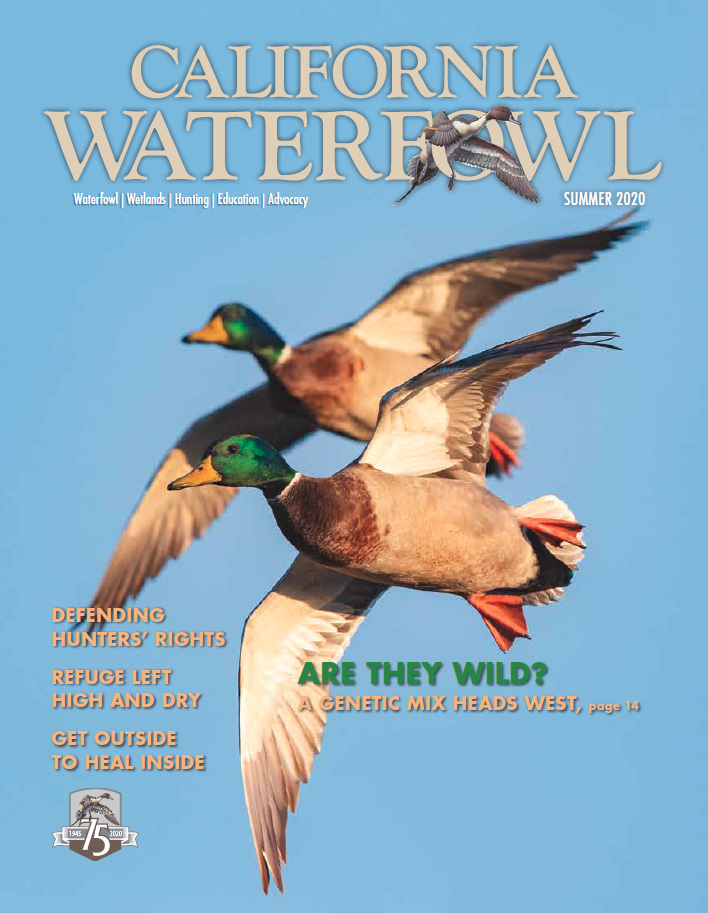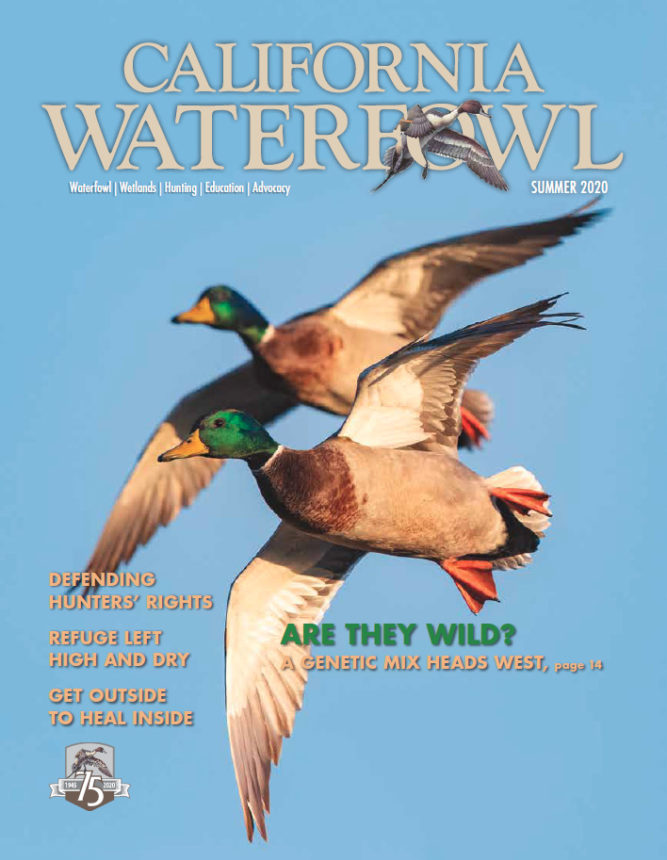
Jun 4, 2020
Summer issue on its way to members
 The summer issue of California Waterfowl will soon be in the hands of members throughout the state. The issue delivers fascinating stories that explore the latest research into waterfowl genetics, offers tips for public-land hunting and evaluates new gear that could make the 2020-21 season your best ever.
The summer issue of California Waterfowl will soon be in the hands of members throughout the state. The issue delivers fascinating stories that explore the latest research into waterfowl genetics, offers tips for public-land hunting and evaluates new gear that could make the 2020-21 season your best ever.
Not a member? Join now by clicking here, then email Crystal Swarny at cswarny@calwaterfowl.org, and she’ll mail you a copy of the issue.
GENETICALLY MODIFIED MALLARDS: Headlining the issue is a strong report by Dr. Philip Lavretsky that exposes a threat to California’s wild mallard population. A large percentage of mallards in the eastern half of the United States have domestic-duck genes. The source is pen-raised ducks that enter the ecosystem mostly through hunting preserves. Domestic genes make the ducks less adaptive in the wild and possibly more susceptible to disease. Those inferior genetics are moving west, through the Mississippi Flyway and the Prairie Pothole Region. Could those game-farm genetics arrive in California in large numbers? Lavretsky explores that question, and asks readers another: Is it enough to say you saw a mallard in the wild, or is it important to be able to say you saw a wild mallard?
FISH CAN’T FLY: Dr. Jacob Katz, the lead scientist at California Trout, contends that the same shallow wetlands that are right for waterfowl are essential for the restoration of endangered Sacramento Valley-run Chinook salmon, and that both fish and fowl can coexist. Through his research at various locations around the Sacramento Valley, such as CWA’s Sanborn Slough duck club, Katz concludes that the main obstacles are levees: They prevent salmon from accessing the floodplains that all ducks, geese and water-birds can easily fly to. And managed floodplains, like those in the Butte Sink, represent the best hope for strong fish and waterfowl populations.
“Historically, California has managed rivers as separate from the landscapes,” writes Katz. “But by recognizing that the flow of water across floodplains is a crucial aspect of water management, we can re-integrate fish, wildlife ad natural processes into the design and operation of the water system.”
California Waterfowl supports voluntary and incentive-based water policy changes in cooperation with landowners as opposed to regulatory changes. Read Katz’s article here.
HARVEST STATS: An extensive “By The Numbers” graphic displays the 2019-20 season in a detailed two-page spread. It shows a harvest better than the previous season’s. Nearly 90,000 hunters harvested more than 194,000 birds at the state’s A and B type wildlife areas and refuges.
REFUGE LEFT TO DRY: CWA’s Jeff Volberg, director of water law and policy, explores emerging factors that spell disaster for the Lower Klamath National Wildlife Refuge in an article called “Refuge Left High and Dry.” Click here to read the article.
HUNTER HEALTH: Dr. Jeffry Metheny breaks down the elements of the outdoors that are an antidote for what ails us, especially during this time of pandemic.
CANINE CORNER: Brought to you by SportDOG® Brand, Josh Miller describes a champion dog that still needs a major tune-up before each hunting season. Miller also writes about keeping your dog safe during summer training and offers tips in order to have the best season ever with your four-legged friend. Read more here.
YOUTH HUNT SCRAPBOOK: We’ve dedicated this issue’s Scrapbook to the kids who took part in the annual Youth Hunt earlier this year. Look for young hunters you know, and see what kind of hunts they had during this special event.
MARSH MOBILITY: Outdoor writer M.D. Johnson puts his years of public-land hunting into words and photos to help you get a limit at wildlife areas and refuges around the state. Johnson describes the gear, techniques and attitude to be successful when there are other hunters jostling for the best spot beneath the flight lines. He also interviews skilled California public-land hunters like Eddie Upton from Biggs and Titus Headings of YouTube’s Mid Valley Mercenaries.
EXCELLENT CALIFORNIA PHOTOGRAPHERS: Photos by Vacaville photographer Brandon Fien, Willows photographer Gary Kramer and San Lorenzo photographer Mike Peters illustrate the wildlife and wetlands that California Waterfowl members value.
Other features and departments include a 2020 Gear Guide by Phil Bourjaily, a look back at the days before live decoys were banned, and the latest efforts by CWA to defend hunters’ rights and promote sustainable use of our state’s natural resources. You can read the Advocacy column by CWA’s Mark Hennelly, brought to you by Federal Premium Ammunition, here.


